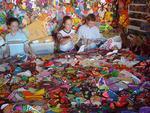Lesson
5:
Comparing the Real and Symbolic Migrations
Background
 |
- Symbolic paper monarchs created in classrooms.
- They first fly first to the staging ground in Minnesota.
- Next they travel with UPS to the Children's Museum in Mexico City.
- Finally, the butterflies come to rest with the school children of Mexico who provide sanctuary for them during the winter.
The real monarch butterflies make a similar migration from their northern breeding grounds to the winter sanctuaries in Mexico.
 |
Make
copies
of this handout for students' journals. |
Activity
- Ask students where they think their symbolic monarchs will go when they leave their classroom. Using information in the background, above, make a class diagram of the "migration" of 63,000 Symbolic Monarchs. The diagram should form a complete circle when monarchs migrate northward in the spring.
- Make a class chart titled Comparisons: The Real and Symbolic Monarch Migrations. Label two columns Real Monarch Migration and Symbolic Monarch Migration. Post the chart and tell students they will be completing it during the course of the school year. Also pass out the chart as a handout, so students can keep notes in their journals.
- Each time you receive weekly Monarch Updates, or conduct relevant lessons about monarchs or symbolic monarchs, revisit and expand the chart. (You might prefer to first fill in the "real" migration side of the chart and then add corresponding information to the "symbolic" side.) The more often you reflect on the symbolism and help students see parallels, the richer their experience will be. The questions below provide some guidance.
Discussion
Use
student responses to add ideas to the comparison chart.
- How do monarchs in both "migrations" find their winter homes? Discuss the monarch's instinctual navigation and the technologies that enable the symbolic monarchs to travel their migration route.
- What routes do the butterflies travel? Display a map of North America to review the migration route made by real monarchs from your home to sanctuaries in Mexico and back again.
- What do the butterflies need to survive their trip and the winter in the sanctuaries? (Think about weather conditions, roosting places, and food and safety requirements.)
- To whom do the monarchs "belong?" Who is responsible for the real and symbolic monarchs after they leave here, travel along their migration route, and cross national borders? (International cooperation is necessary for the survival of migratory species.)
- When do the monarch butterflies arrive in Mexico? When do they return in the spring?
- How do you think people in Mexico respond to the real monarchs' return? To the symbolic monarchs they receive?
- What risks to "survival" do the symbolic and the real monarchs face along the migration trail and in the sanctuaries during winter? What things can go wrong? (This will help students better understand why they might receive fewer Symbolic Monarchs than they sent.) Remind students that not all real or symbolic monarchs will survive the migration.
- Is a butterfly that returns in the spring something we can take for granted, or should we regard it as a "gift?" Plan how the class might make the most of the symbolic monarchs that do return from Mexico. (For instance, you might make a hallway display.)


